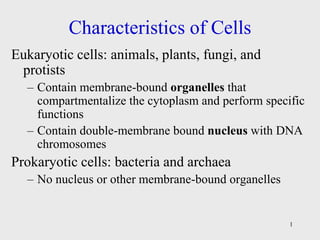
Chapt04 lecture
- 1. 1 Characteristics of Cells Eukaryotic cells: animals, plants, fungi, and protists – Contain membrane-bound organelles that compartmentalize the cytoplasm and perform specific functions – Contain double-membrane bound nucleus with DNA chromosomes Prokaryotic cells: bacteria and archaea – No nucleus or other membrane-bound organelles
- 3. Figure 4.1 Structure of a bacterial cell 3
- 4. 4 4.3 External Structures • Appendages – Two major groups of appendages: • Motility – flagella and axial filaments (periplasmic flagella) • Attachment or channels – fimbriae and pili • Glycocalyx – surface coating
- 5. 5 Flagella • 3 parts: – Filament – long, thin, helical structure composed of protein Flagellin – Hook – curved sheath – Basal body – stack of rings firmly anchored in cell wall • Rotates 360o • Number and arrangement of flagella varies: – Monotrichous, lophotrichous, amphitrichous, peritrichous • Functions in motility of cell through environment
- 7. 7 Flagellar Arrangements 1. Monotrichous – single flagellum at one end 2. Lophotrichous – small bunches emerging from the same site 3. Amphitrichous – flagella at both ends of cell 4. Peritrichous – flagella dispersed over surface of cell; slowest
- 8. Figure 4.3 Electron micrographs of flagellar arrangements 8
- 9. 9 Flagellar Responses Guide bacteria in a direction in response to external stimulus: Chemical stimuli – chemotaxis; positive and negative Light stimuli – phototaxis Signal sets flagella into rotary motion clockwise or counterclockwise: Counterclockwise – results in smooth linear direction – run Clockwise – tumbles
- 10. 10 Fimbriae • Fine, proteinaceous, hairlike bristles emerging from the cell surface • Function in adhesion to other cells and surfaces
- 11. 11 Pili • Rigid tubular structure made of pilin protein • Found only in gram-negative cells • Function to join bacterial cells for partial DNA transfer called conjugation
- 12. 12 Glycocalyx • Coating of molecules external to the cell wall, made of sugars and/or proteins • Two types: 1. Slime layer - loosely organized and attached 2. Capsule - highly organized, tightly attached • Functions: – Protect cells from dehydration and nutrient loss – Inhibit killing by white blood cells by phagocytosis, contributing to pathogenicity – Attachment - formation of biofilms
- 13. 13
- 14. 14
- 15. Figure 4.11 Biofilm on a catheter 15
- 16. Table 4.1 Comparison of Gram-Positive and Gram-Negative 16
- 17. 17 Nontypical Cell Walls • Some bacterial groups lack typical cell wall structure, i.e., Mycobacterium and Nocardia – Gram-positive cell wall structure with lipid mycolic acid (cord factor) • Pathogenicity and high degree of resistance to certain chemicals and dyes • Basis for acid-fast stain used for diagnosis of infections caused by these microorganisms • Some have no cell wall, i.e., Mycoplasma – Cell wall is stabilized by sterols – Pleomorphic
- 18. Figure 4.15 Extreme variation in shape of Mycoplasma pneumoniae 18
- 19. 19 Cell Membrane Structure • Phospholipid bilayer with embedded proteins – fluid mosaic model • Functions in: – Providing site for energy reactions, nutrient processing, and synthesis – Passage of nutrients into the cell and the discharge of wastes • Cell membrane is selectively permeable
- 20. 20 4.5 Bacterial Internal Structures • Cell cytoplasm: – Dense gelatinous solution of sugars, amino acids, and salts – 70-80% water • Serves as solvent for materials used in all cell functions
- 21. 21 • Chromosome – Single, circular, double-stranded DNA molecule that contains all the genetic information required by a cell – Aggregated in a dense area called the nucleoid • DNA is tightly coiled Bacterial Internal Structures
- 22. Figure 4.17 Chromosome structure 22
- 23. 23 Bacterial Internal Structures • Plasmids – Small circular, double-stranded DNA – Free or integrated into the chromosome – Duplicated and passed on to offspring – Not essential to bacterial growth and metabolism – May encode antibiotic resistance, tolerance to toxic metals, enzymes, and toxins – Used in genetic engineering - readily manipulated and transferred from cell to cell
- 24. 24 Bacterial Internal Structures • Ribosomes – Made of 60% ribosomal RNA and 40% protein – Consist of two subunits: large and small – Prokaryotic differ from eukaryotic ribosomes in size and number of proteins – Site of protein synthesis – Present in all cells
- 25. 25 Bacterial Internal Structures • Inclusions and granules – Intracellular storage bodies – Vary in size, number, and content – Bacterial cell can use them when environmental sources are depleted – Examples: glycogen, poly b-hydroxybutyrate, gas vesicles for floating, sulfur and phosphate granules (metachromatic granules), particles of iron oxide
- 26. Figure 4.19 Bacterial inclusion bodies 26
- 27. 27 Bacterial Internal Structures • Endospores – Inert, resting, cells produced by some G+ genera: Clostridium, Bacillus, and Sporosarcina • Have a 2-phase life cycle: – Vegetative cell – metabolically active and growing – Endospore – when exposed to adverse environmental conditions; capable of high resistance and very long-term survival – Sporulation - formation of endospores • Hardiest of all life forms • Withstands extremes in heat, drying, freezing, radiation, and chemicals • Not a means of reproduction – Germination - return to vegetative growth
- 28. Figure 4.22 Sporulation cycle 28
- 29. 29 Endospores • Resistance linked to high levels of calcium and dipicolinic acid • Dehydrated, metabolically inactive • Thick coat • Longevity verges on immortality, 250 million years • Resistant to ordinary cleaning methods and boiling • Pressurized steam at 120oC for 20-30 minutes will destroy
- 30. 30 4.6 Bacterial Shapes, Arrangements, and Sizes • Vary in shape, size, and arrangement but typically described by one of three basic shapes: – Coccus – spherical – Bacillus – rod • Coccobacillus – very short and plump • Vibrio – gently curved – Spirillum – helical, comma, twisted rod, • Spirochete – spring-like
- 31. Figure 4.23 Common bacterial shapes 31